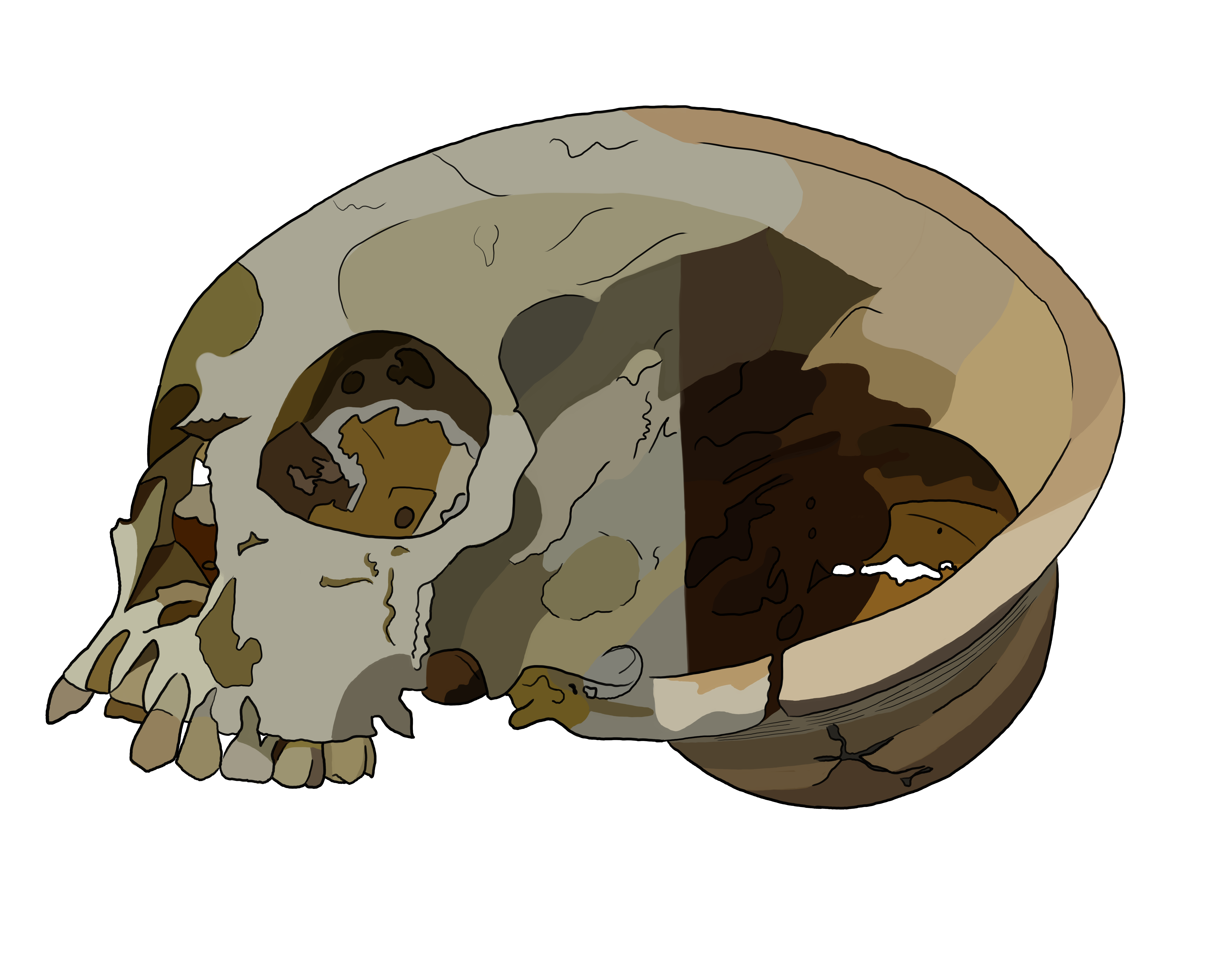I’ve had several people comment on the unique skull shape of the Achavanich individual. It is hard to see in photographs what is being referred to so I have created an illustration to try and give you a better idea.

The arrows around the outline of the skull highlight areas of potential abnormality. If you look carefully at the arrows on the view from the back (in the bottom right hand corner) you will see the angles on each side are quite dis-similar.The side view (left) also shows the flat top and side has a particularly sharp change in angle. Compared to other skulls, this is quite distinct.
I hoped this helps to explain what we are referring to when we mention the irregularity, unique or abnormal shape of the skull.
Edit:
I have created a second illustration, which shows the Achavanich individual (partial rough reconstruction shown in light blue) in comparison with a relatively normal/average skull shape (copied from isknonews.org). Hopefully this, again, helps to highlight the distinct shape of the back of the head (again highlighted by the arrows).

As always: comments, thoughts and ideas are warmly welcomed.
Regards,
Maya

The back of the skull makes me think of Native American children who were kept in cradle boards. Have you compared the skull to one of those? As for dissimilar angles, I know the two sides of my skull are dissimilar. My father was an awful loud snorer and I grew up trying to sleep facing away from my bedroom door and with my head jammed under the pillow. It might be due to some sort of habitual prosaic practice.
LikeLiked by 2 people
Not being knowledgeable re this subject, but a friend has a gdaughter who was born immature & had to stay in neonatal unit for months. Last year I noticed the childs jaw & bones of skull on one side of face were misshapen & looked to be pushed back & not lining up with her nose & cheekline. I believe the child is 7/8. I was told that it was because of being premature & hospitalized for long time & lying on that side of face. I can’t see that that side of face will catch up and be symmetrical. She may grow into an adult with deformity.
LikeLiked by 1 person
Have you analyzed genetic material to determine HSN (Homo Sapiens Neanderthals) admixture ratio? Many modern Europeans of this region cary 2-4% and may express old HSN traits through archaic retrogression. In bronze-age cultures the isolation required to preserve and refine HNS traits may be in play. I’m curious about the history of this admixture in ancient Europe, and just superficially I see some interesting potential in the larger / closer eyes, low flat head, etc.
LikeLiked by 1 person
Hi Joe, thanks for your comment. No – this isn’t something we’ve been able to do. Have you any references I could read up on about this?
Thanks,
Maya
LikeLike
Wonderful! Commercially this is available on a consumer-grade level to living people via 23andme. (I’m 2.9%) This uses a saliva test for genotyping (detecting a catalog of SNPs), and of course is not appropriate for your needs. However if you have done a full gene sequence or even genotyped the samples, there are numerous resources for comparing the Neanderthall, Denisovan, and presumably other early european admixtures.
Here are some basic places to read more. I’m not sure what level if info you would like.
Introductory:
https://phys.org/news/2016-03-world-neanderthal-denisovan-ancestry-modern.html
More scholarly:
http://www.nature.com/nature/journal/v505/n7481/full/nature12886.html
http://www.eva.mpg.de/neandertal/index.html
And right in between (about my speed 🙂
http://humanorigins.si.edu/evidence/genetics/ancient-dna-and-neanderthals/neanderthal-genes-red-hair-and-more
LikeLike
Great, thanks for this, I’ll check it out. The aDNA analysis is being done as part of a larger separate research project so we will need to wait a while for the new data. Thanks!
LikeLike
Given the elaborate nature of the burial chamber and the relative youth of the girl, is it possible that she suffered from a long-tail, incapacitating illness that rendered her incapable of moving herself and that caused a misshapen skull over time?
I’m no expert in any regard, but my point is that I would not be surprised to find out that Stephen Hawking’s skull was misshapen due to long-term inability to move himself.
LikeLiked by 1 person
Hi Dave, thanks for your question. Was fascinated to have a look at your website – where are you based?
We have evidence from Ava’s vertebrae that suggests she was actively involved in manual labour, or that she lived an active lifestyle. But, it is highly possible that as a child she was swaddled, and slept in a specific way that meant as she developed in her early years, she didn’t get the opportunity to roll her head around and, perhaps, that’s where the flat shape comes from.
LikeLike